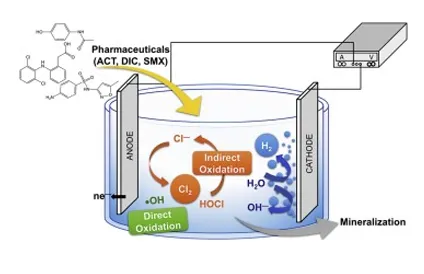In electrooxidation process, electric current applied into the electrolytic chamber (electrooxidation reactor / cell ) causes the colloidal impurities to de-stabilize, resulting in agglomeration and flotation and subsequent removal. Dissolved impurities contributing BOD / COD also get oxidized due to the oxidizing agents released by the electrolytic solution which changes them into a state that is either less colloidal and less emulsified (or soluble) . The contaminants get precipitated and can easily be removed by secondary separation techniques.

Electro-oxidation (EO), also known as anodic oxidation, is a technique used for wastewater treatment, mainly for industrial effluents, and is a type of advanced oxidation process (AOP). The most general layout comprises two electrodes, operating as anode and cathode, connected to a power source. When an energy input and
sufficient supporting electrolyte are provided to the system, strong oxidizing species are formed, which interact with the contaminants and degrade them. The refractory compounds are thus converted into reaction intermediates and, ultimately, into water and CO2 by complete mineralization.
Electro-oxidation has recently grown in popularity thanks to its ease of set-up and effectiveness in treating harmful and recalcitrant organic pollutants, which are typically difficult to degrade with conventional wastewater remediation processes. Also, it does not require any external addition of chemicals (contrarily to other processes like in-situ chemical oxidation), as the required reactive species are generated at the anode surface.
Electro-oxidation has been applied to treat a wide variety of harmful and non-biodegradable contaminants, including aromatics, pesticides, drugs and dyes. Due to its relatively high operating costs, it is often combined with other technologies, such as biological remediation.